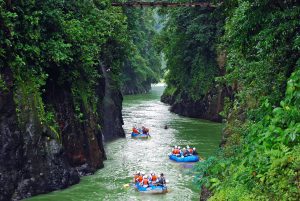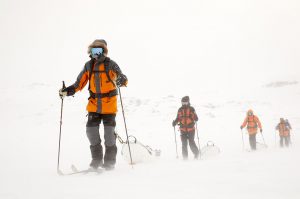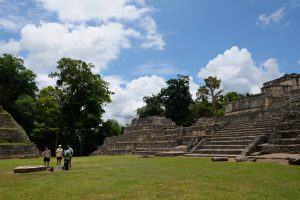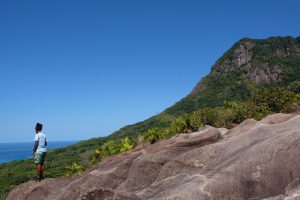
Iguazu Falls, Argentina
Follow these adventure-ready backpacker tips and join the so-called ‘Gringo Trail’
Read online at natgeotraveller.co.uk
Lost City trek, Colombia
Starting out in the northwest city of Santa Marta, not far from the Caribbean coast, is the popular 28-mile forest trek through the steamy Sierra Nevada Mountains to La Ciudad Perdida — a 9th-century ruined city, known locally as ‘Teyuna’. The four-to-six-day hike can’t be done independently, but there are a handful of authorised operators; it’s a good idea to pick one that provides indigenous guides, who can offer insights into the history and culture of the region. While the trekking itself isn’t too challenging, it’s important to pack well and light.
La Paz & around Bolivia
Getting by in Bolivia is cheap, so breaking the bank in lofty La Paz shouldn’t be an issue — especially as some of the city’s best attractions aren’t ticketed. Browse for trinkets and charms in Mercado de las Brujas (Witches’ Market), enjoy the colourful houses and bars of Calle Jaén, or explore the frenetic, eye-opening neighbourhood of El Alto. There are a number of adventurous excursions offered by tour groups based in La Paz, from climbing Huayna Potosí to mountain biking down the infamous dirt track — dubbed ‘Death Road’ — into the Yungas Valley. The importance of doing prior research and paying the extra for reputable companies that offer top-end kit and experienced guides can’t be overstated.
Cusco & Machu Picchu, Peru
Up to 500 people are permitted to head out on the Inca Trail to Machu Picchu every day, but this can mean booking months, if not years, in advance and forking out a small fortune. From pretty, colonial Cusco it’s possible to book last-minute onto a number of cheaper, alternative hikes to the fabled mountain-top ruins; the city centre is awash with tour agencies, and hostels can advise on which to approach. Consider the five-day Salkantay trail or the Lares Trek, both of which have landscapes to rival the most famous route. Cusco itself is a great place to linger: enrol in a short language course, people-watch in Plaza de Armas, or hire bicycles to explore the Sacred Valley.
Rio de Janeiro, Brazil
Great news: contrary to popular belief, travellers don’t need deep pockets to backpack through Rio. The stunning natural attractions of Brazil’s sun-drenched, Samba-the-night-away southern city are free, so make like the cariocas (locals) do and split days between the beaches and green spaces, such as the Floresta de Tijuca, Lagoa Rodrigo de Freitas and Parque de Flamengo. Museums often offer free admission on selected days; inexpensive cuisine can be found at street stalls or ‘per kilo’ restaurants; and buses or the air-conditioned Metro are pocket-pleasing alternatives to taxis. It’s also possible to skip the cable car and hike up to Christ the Redeemer; this will save those all-important reais for night-time caipirinhas. In terms of accommodation, it’s advisable to visit during the off-season (prices match the high temperatures December-March), and take advantage of a new crop of cheap and charming guesthouses appearing in the inland neighbourhoods of Santa Teresa, Flamengo, or Laranjeiras — each of which are attractive, historically interesting and refreshingly untouristy.
Iguazu Falls, Argentina
Thundering amid the lush rainforest of northeastern Argentina is Iguazu Falls, a collection of 275 cascades that collectively spill over the Parana Plateau to create one of the world’s most spectacular waterfalls. The Falls straddle the border with Brazil and, while the latter side is famed for its panoramic views, the variety of walks and activities in Argentina’s Parque Nacional Iguazú make for a fuller day out. Here, take a speedboat up close to the crashing waters, stare over the ledge of the falls into the Garganta de Diablo (Devil’s Throat), hop aboard a jungle railway, or sunbathe and picnic among butterflies on San Martin Island. A day ticket costs tourists ARS$330 (£17), and accommodation in nearby Puerto Iguazu can be pricey. Visitors can save further expense by bringing their own water, food, sun cream and insect spray to avoid the park’s overpriced shops.
Backpacker tips
Eat street food
If locals are queuing up to buy it, then you can be pretty sure it’s both delicious and hygienic.
Don’t be afraid
Don’t flash valuables or go anywhere with a bad reputation at night (ask around if you’re unsure). Research popular scams prior to navigating a touristy place, and know roughly how much a taxi from the airport to the city centre should be, to avoid getting ripped off.
Learn the lingo
Away from the famous sights, English isn’t widely spoken. A few key phrases will be invaluable, and will earn you goodwill with the locals.
Meet local people
If travelling is about experiencing a different culture, then getting to know people who grew up on the other side of the world is surely a must. South American culture is much more gregarious than British: say hello to a fellow commuter on a bus and you may end up getting invited to a family dinner.
Wake up early
Jet lag is no excuse: seize the day. And if you’re heading somewhere famous, it’s the only way to dodge the crowds.
Try couchsurfing
The network is a great way to meet people and save on accommodation, but check out the social events, too — perfect if you’re looking for a language exchange partner or a bit of local insight. couchsurfing.com
Published in the South America 2016 guide, distributed with the October 2016 issue of National Geographic Traveller (UK)











